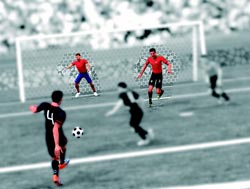Dual spotlights in the brain

The striker has to divide his attention: He has to attend to the goalkeeper, but also to player #3 who might block his shot. By splitting his ‘spotlight of attention’ he stays on top of the situation. To ensure that his information processing capacities are not overtaxed he is able to suppress the irrelevant information next to and between his two attentional foci. This provides him with all the necessary information in optimal quality and without distraction. This process is visualized in the picture through various degrees of blurriness.<br>Image: Christian Kiel/ Fuchstrick GbR<br>
The “tiki-taka”-style of the Spanish national football team is amazing to watch: Xavi passes to Andrès Iniesta, he just rebounds the ball once and it’s right at Xabi Alonso’s foot. The Spanish midfielders cross the field as if they run on rails, always maintaining attention on the ball and the teammates, the opponents chasing after them without a chance.
An international team of scientists from the German Primate Center and McGill University in Canada, including Stefan Treue, head of the Cognitive Neuroscience Laboratory, has now uncovered how the human brain makes such excellence possible by dividing visual attention: The brain is capable of splitting its ‘attentional spotlight’ for an enhanced processing of multiple visual objects. (Neuron, doi: 10.1016/j.neuron.2011.10.013)
When we pay attention to an object, neurons responsible for this location in our field of view are more active then when they process unattended objects. But quite often we want to pay attention to multiple objects in different spatial positions, with interspersed irrelevant objects. Different theories have been proposed to account for this ability. One is, that the attentive focus is split spatially, excluding objects between the attentional spotlights. Another possibility is, that the attentional focus is zoomed out to cover all relevant objects, but including the interspersed irrelevant ones. A third possibility would be a single focus rapidly switching between the attended objects.
Studying rhesus macaques
In order to explain how such a complex ability is achieved, the neuroscientists measured the activity of individual neurons in areas of the brain involved in vision. They studied two rhesus macaques, which were trained in a visual attention task. The monkeys had learned to pay attention to two relevant objects on a screen, with an irrelevant object between them. The experiment showed, that the macaques’ neurons responded strongly to the two attended objects with only a weak response to the irrelevant stimulus in the middle. So the brain is able to spatially split visual attention and ignore the areas in between. “Our results show the enormous adaptiveness of the brain, which enables us to deal effectively with many different situations.
This multi-tasking allows us to simultaneously attend multiple objects”, Stefan Treue says. Such a powerful ability of our attentive system is one precondition for humans to become perfect football-artists but also to safely navigate in everyday traffic.
Original Publication
Robert Niebergall, Paul S. Khayat, Stefan Treue, Julio C. Martinez-Trujillo (2011): Multifocal attention filters out targets from distractors within and beyond primate MT neurons receptive field boundaries. Neuron, Volume 72, Issue 6, 1067-1079, 22 December 2011. doi: 10.1016/j.neuron.2011.10.013
Contact
Prof. Dr. Stefan Treue
Phone: +49 551 3851-117
E-mail: treue@gwdg.de
Susanne Diederich (Press and Communications)
Phone: +49 551 3851-359
E-mail: sdiederich@dpz.eu
The German Primate Center (DPZ) in Göttingen, Germany, conducts basic research on and with primates in the areas of infectious diseases, neurosciences and organismic biology. In addition, it operates four field stations abroad and is a competence and reference center for primate research. The DPZ is one of the 86 research and infrastructure institutions of the Leibnitz Association in Germany (http://www.leibniz-gemeinschaft.de).
Media Contact
All latest news from the category: Life Sciences and Chemistry
Articles and reports from the Life Sciences and chemistry area deal with applied and basic research into modern biology, chemistry and human medicine.
Valuable information can be found on a range of life sciences fields including bacteriology, biochemistry, bionics, bioinformatics, biophysics, biotechnology, genetics, geobotany, human biology, marine biology, microbiology, molecular biology, cellular biology, zoology, bioinorganic chemistry, microchemistry and environmental chemistry.
Newest articles

High-energy-density aqueous battery based on halogen multi-electron transfer
Traditional non-aqueous lithium-ion batteries have a high energy density, but their safety is compromised due to the flammable organic electrolytes they utilize. Aqueous batteries use water as the solvent for…

First-ever combined heart pump and pig kidney transplant
…gives new hope to patient with terminal illness. Surgeons at NYU Langone Health performed the first-ever combined mechanical heart pump and gene-edited pig kidney transplant surgery in a 54-year-old woman…

Biophysics: Testing how well biomarkers work
LMU researchers have developed a method to determine how reliably target proteins can be labeled using super-resolution fluorescence microscopy. Modern microscopy techniques make it possible to examine the inner workings…





















